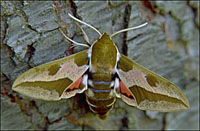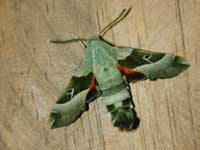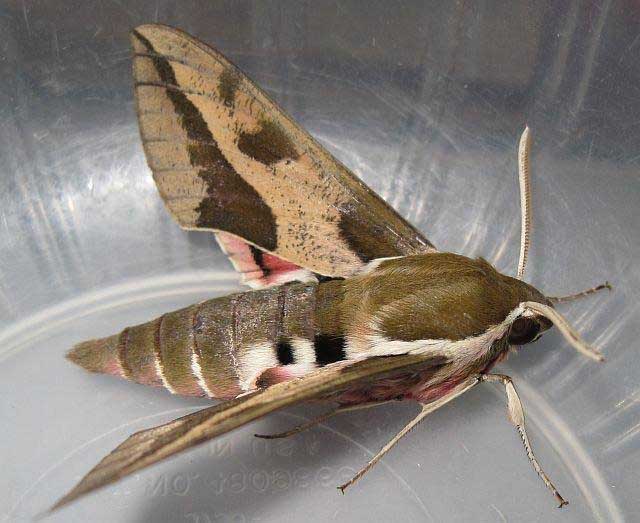Sphinginae subfamily
Sphingini Tribe:
 |
Ceratomia undulosa
WO,
the Waved Sphinx:
The upperside of the forewing is pale brownish gray with wavy black and white lines and a black-outlined white cell spot.
The upperside of the hindwing is gray with diffuse darker bands. possibility, generally more southerly in Wyoming.
|
 |
The costal area in the basal and median areas of the forewing is light grey. This colour also
appears in the terminal area. The rest of the wing is dark slatey grey.
|
 |
Sphinx luscitiosa
WO,
the Canadian Sphinx or
Clemen's Sphinx:
The upperside of the forewing is yellowish gray in males and pale gray with a faint yellow tint in females. In both sexes,
the dark border on the outer margin widens as it approaches the inner margin.
The upperside of the hindwing is deep yellow in males, pale yellow in females; both with a wide black border.
|
 |
The upperside of the forewing has a narrow black subterminal line
bordered by a white inverted V-shaped line on the outside, and a
black line running inwards from the apex of the wing.
It is most often found in montane woodlands and along streamcourses. |
Smerinthini Tribe:
 |
Pachysphinx modesta
WO,
the Modest Sphinx or Poplar Sphinx.
The forewing is grey brown with diffuse lines.
The hindwing is bergundy with dark blue to black markings near the anal angle.
|
 |
This one is quite similar to Pachysphinx modesta, with modesta
being smaller and darker.
Forewing lines are more distinct in P. occidentalis as compared
to P. modesta.
There may be naturally occuring hybrids in Laramie.
|
 |
The grey-blue eyespot of the hindwing gives this species its name.
Larvae feed on birches, willows, cherries and oaks.
The outer edge of the forewings is quite scalloped. |
 |
This small species is widespread and common and is likely present. This species ranges across North America.
The hindwings have a small blue eyespot ringed with black on a yellow background.
|
 |
If you have willows and poplars nearby, you've probably got populations of
the Cerisyi's Sphinx. The hindwings are quite striking.
|
Macroglossinae subfamily
Dilophonotini Tribe
 |
Hemaris diffinis
WO, the
Snowberry Clearwing or Bumblebee Moth
This moth is widespread and is present at least in the northeastern
part of Wyoming. It may fly throughout the state.
|
 |
Hemaris thysbe
WO, the Hummingbird Clearwing
It is not difficult to see why many gardeners would mistake an Hemaris thysbe moth for a small hummingbird as it hovers,
sipping nectar from flowers through a long feeding tube.
|
Macroglossini Tribe
 |
Hyles euphorbiae
EW, the Spurge Hawk Moth
The body is light brown with various white and dark brown
markings, while the wings have a conspicuous tan, brown, and pink or
red color pattern.
|
Hyles euphorbiae, June 24, 2012, Edna Woodward
 |
Hyles gallii
WO,
the Bedstraw Hawk Moth or Gallium Sphinx
This forewing is dark brown with a slightly irregular cream-coloured transverse line.
The outer margin is grey. There is a bright pink band on the hindwing.
|
 |
Hyles lineata
WO, the White-lined Sphinx
This species is very widespread. It can be seen flying during the day,
into the evening and also at night.
The highly variable larvae are often found in people's gardens. |
 |
The upperside of the forewing is pale gray-green with a deep
green-brown median area and a white dash at the wing tip.
|
|
|


